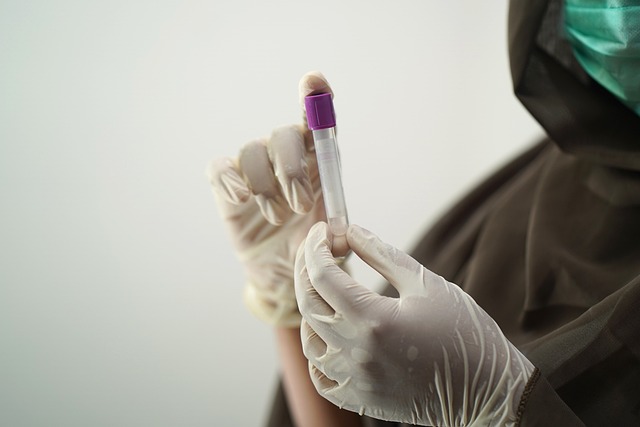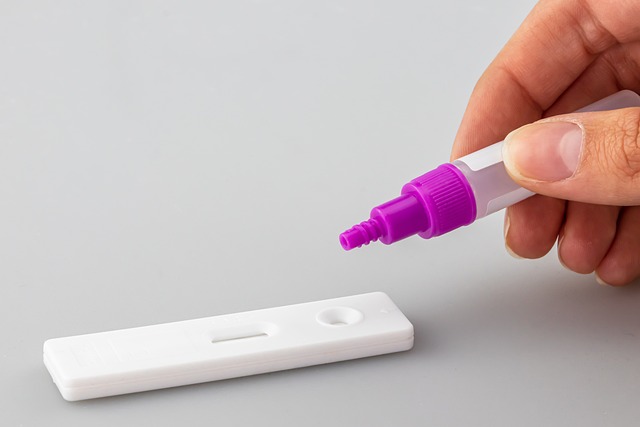The UK Testosterone Blood Test is a multifaceted diagnostic tool for assessing iron deficiency anemia and hormonal health, particularly testosterone levels. In the UK, diagnosing this condition begins with a hemoglobin test to identify anemia; if low, ferritin testing follows to determine iron stores, with serum iron and total iron-binding capacity (TIBC) tests providing additional insights into iron management. The UK Testosterone Blood Test also evaluates testosterone levels, which can be affected by iron deficiency, especially in males where both conditions may coexist. A complete blood count (CBC) initiates the diagnostic process, with subsequent ferritin measurements crucial for gauging iron reserves. The comprehensive approach combining these tests ensures accurate diagnosis and effective treatment planning for iron deficiency anemia, reducing complications and enhancing patient care. For those interested in their hormonal health, understanding the timing and interpretation of the UK Testosterone Blood Test is vital, as it offers the most accurate assessment of testosterone levels in the morning when levels peak. This holistic evaluation, incorporating patient history, physical examination, and additional tests as needed, allows healthcare providers to tailor recommendations and treatments based on individual testosterone profiles for personalized hormonal health management.
Iron deficiency anemia is a prevalent health concern, particularly in the UK where accurate diagnosis and monitoring are paramount. This article delves into the nuances of detecting iron deficiency anemia through blood tests, emphasizing the importance of hemoglobin, ferritin, and serum iron measurements, and providing guidance on the UK Testosterone Blood Test as a key assessment tool for comprehensive hormonal health. Understanding these diagnostic measures equips individuals with the knowledge to navigate their health effectively.
- Understanding Iron Deficiency Anemia and Its Diagnosis in the UK Through Blood Tests
- The Role of Hemoglobin, Ferritin, and Serum Iron Levels in Detecting Iron Deficiency Anemia
- Navigating the UK Testosterone Blood Test: A Guide to Comprehensive Hormonal Health Assessment
Understanding Iron Deficiency Anemia and Its Diagnosis in the UK Through Blood Tests

Iron deficiency anemia is a prevalent condition characterized by insufficient iron levels, leading to an inadequate number of healthy red blood cells. In the UK, the most definitive approach for diagnosing this condition is through blood tests. These tests measure various components of your blood, including haemoglobin, ferritin, serum iron, and transferrin saturation. The UK Testosterone Blood Test, which assesses testosterone levels alongside iron metrics, can be particularly useful as low testosterone may coexist with iron deficiency anemia in some cases, affecting male health and overall well-being.
Healthcare providers consider several indicators when diagnosing iron deficiency anemia. The initial step typically involves a complete blood count (CBC) to evaluate the overall red blood cell counts and haemoglobin levels. If abnormalities are detected, further tests such as serum ferritin measurement are conducted to determine iron stores within the body. A low ferritin level is often indicative of iron deficiency. In addition, serum iron and total iron-binding capacity (TIBC) tests help in assessing the body’s iron utilization and availability. These diagnostic methods enable accurate identification and management of iron deficiency anemia, ensuring individuals receive timely treatment to restore health and prevent complications associated with this condition.
The Role of Hemoglobin, Ferritin, and Serum Iron Levels in Detecting Iron Deficiency Anemia

Iron deficiency anemia, characterized by insufficient iron levels in the body leading to a reduction in hemoglobin and thus red blood cell count, can be effectively detected through a variety of blood tests. Hemoglobin is a critical component of red blood cells responsible for transporting oxygen throughout the body. Its concentration in the blood is a primary indicator of anemia; a low hemoglobin level often signals iron deficiency. In the UK, a hemoglobin test is typically the first step in diagnosing anemia, providing immediate insights into the patient’s condition.
In addition to hemoglobin levels, ferritin and serum iron are pivotal markers in identifying iron deficiency anemia. Ferritin, a protein that stores iron in the body, serves as a reliable indicator of iron stores. Elevated or low ferritin levels can indicate either iron excess or depletion, respectively. Serum iron levels, another key measure, reflect the amount of iron available for use by the body and can help differentiate between different types of anemia. When combined with other diagnostic tests such as the UK Testosterone Blood Test, which may be relevant in assessing overall hormonal health, these markers provide a comprehensive picture of iron status. Healthcare providers utilize these tests to tailor treatment plans, ensuring patients receive the most appropriate care for their specific needs, thereby underscoring the importance of these diagnostic measures in managing iron deficiency anemia.
Navigating the UK Testosterone Blood Test: A Guide to Comprehensive Hormonal Health Assessment

For individuals in the UK seeking a thorough evaluation of their hormonal health, particularly concerning testosterone levels, understanding the intricacies of the Testosterone Blood Test is paramount. This guide aims to demystify the process, ensuring clarity and comprehension for those navigating this path. The UK Testosterone Blood Test is a critical diagnostic tool that measures the concentration of testosterone in the bloodstream, which can be indicative of a person’s overall hormonal balance. It is essential to understand the timing and context of such tests; testosterone levels fluctuate throughout the day, making it important to adhere to specific guidelines before the test. Generally, a morning sample provides the most accurate reading as testosterone levels are at their peak during this time.
When undergoing a Testosterone Blood Test in the UK, it is crucial to engage with healthcare providers who are well-versed in interpreting the results within the broader context of an individual’s health. This involves considering not only the raw figures but also understanding the reference ranges specific to the laboratory conducting the test. A proper hormonal health assessment goes beyond a mere numerical value; it encompasses a comprehensive approach that includes a thorough patient history, physical examination, and possibly further diagnostic tests if necessary. By doing so, healthcare professionals can offer tailored advice and treatment options to address any imbalances or deficiencies in testosterone levels effectively.
In conclusion, iron deficiency anemia is a prevalent condition that can be effectively detected and managed through robust diagnostic methods available in the UK, notably including blood tests. These tests measure key indicators such as hemoglobin, ferritin, and serum iron levels, which are pivotal in identifying this health issue. Furthermore, for those assessing hormonal health, particularly regarding testosterone levels, understanding the nuances of the UK Testosterone Blood Test is crucial for accurate diagnosis and treatment planning. The insights provided by such tests enable healthcare professionals to tailor interventions to individual needs, ensuring better patient outcomes. Thus, it’s clear that blood tests play a vital role in the early detection and management of iron deficiency anemia within the UK healthcare system, underpinning the importance of these diagnostic tools for maintaining comprehensive health assessments.
